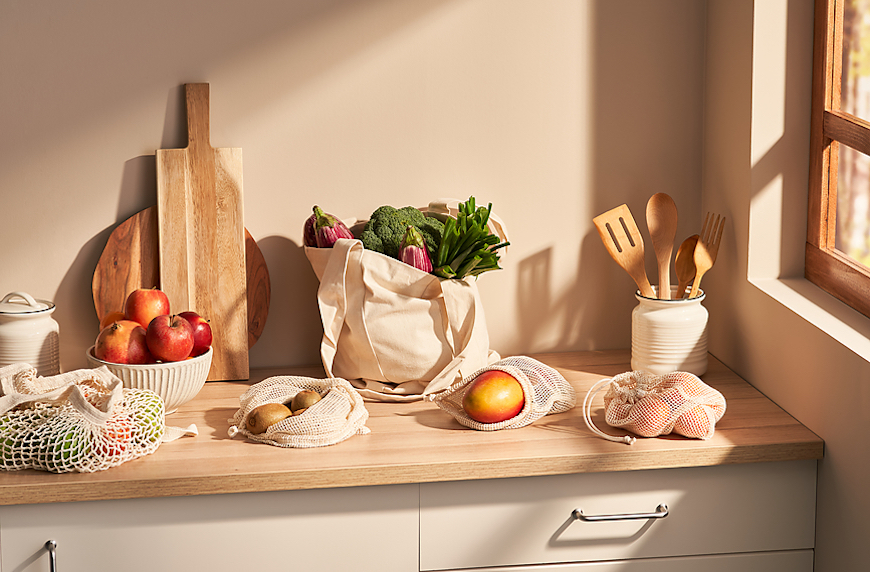
January 22, 2020 at 01:00PM by CWC
It’s a beautiful fact that when you eat a primarily plant-based diet, you’re benefiting both your body and the planet. (And your wallet too; plant-based foods tend to be inexpensive.)
But if you’re new to the whole plant-based eating thing, chances are that there are a few concerns on your mind, nutritionally speaking. Some wonder how they’re going to get enough protein with meat put on the back burner. Or maybe you want to make sure you’re getting enough omega-3s, wondering what sources other than fish can help give your brain a boost. Consider this your ultimate guide.
Here, Cleveland Clinic registered dietitian Julia Zumpano, RD and registered dietitian Maggie Michalczyk, RD both give tips on how to make sure you’re getting all the nutrients you need every day while sticking to a plant-based diet—and prioritizing sustainability, too. Use the food pyramid graphic here as a tool to see what foods to prioritize on your plate and to make sure you get enough servings of each to fuel your body.

The base of the pyramid: vegetables and fruit
ADVERTISEMENT
ADVERTISEMENTKate Spade Autumn/Winter Sale |
Both Zumpano and Michalczyk say that the most important part of plant-based eating is vegetables—aim to devote a full 50 percent of every meal to them. “The goal should be to get a minimum of seven to nine servings of vegetables a day and two to three servings of fruit,” Zumpano says. Some examples of what a healthy serving looks like: a half-cup of cooked vegetables, one cup of leafy greens or raw vegetables, one entire medium sized fruit (like an apple, orange, or banana), or two whole small fruits (like plums or kiwis).
Nutritionally, vegetables and fruits provide fiber, antioxidants, a small amount of protein, and a wide range of nutrients and minerals. Michalczyk says vegetables and fruits are the most sustainable foods, too, though she notes that they still take energy to grow. “A lot of farmers, growers, and businesses are implementing more practices to increase the sustainability of their crops,” she says. One example of this is crop rotation, where you grow different kinds of plants on the same plot of land, to ensure the soil stays nutrient-rich.
The second level: whole grains
Whole grains such as rice, quinoa, millet, corn, barley, and buckwheat rank second in terms of importance on a plant-based diet. One Harvard study found that eating three half-cup servings of whole grains a day is linked to living a longer life. The same study also found that eating this amount is linked to lowering the risk of heart disease, stroke, and type 2 diabetes. “This is because whole grains are good sources of fiber, protein, and vitamins,” Zumpano says.
Despite carbs getting a bad rap from the larger wellness community of late, Michalczyk emphasizes that they are important for overall health, and the type of carb matters. “You want to limit carb sources from processed foods, but whole grains are full of fiber and nutrients,” she says.
Whole grains grow quickly and easily, not requiring rich soil or much rain. So while they do require more energy to harvest than fruits and vegetables, they are still highly sustainable, making them a win for the environment, too.
The third level: plant-based protein
PSA: Not only can you get all the protein your body needs from plants (provided you’re smart about optimizing for complete proteins), it’s much more sustainable than a primarily meat-based diet. Zumpano says legumes (including soy, chickpeas, lentils, and lupini beans), nuts, and seeds are all good sources to prioritize. “Protein needs are calculated using body weight. A quick rule of thumb is half your weight should be your minimum protein needs in grams,” she explains. “For example, a 150 pound person should get a minimum of 75 grams of protein per day.” If you work out a lot, you’ll likely need more.
Michalczyk points out that whole grains—on the second level of the pyramid—are a good source of protein too. For example, one cup of cooked brown rice has eight grams of protein and one cup of quinoa has 24 grams of protein.
Of these sources, legumes are the best for the environment because they are nitrogen fixers, which is good for soil health. (Basically, they take nitrogen from the air and hold it in the soil, which lessens the need for fertilizers.) While nuts require more water than other foods to produce (particularly almonds), they still have a lower environmental impact than animal protein.
The fourth level: healthy fats and dairy
“Healthy fats are definitely an important part of the diet for a variety of reasons, including health benefits [proving energy and boosting heart health] and satiety of a meal,” Michalczyk says. The goal should be to get between 55 and 66 grams of healthy fats a day, and Michalczyk says good sources include avocado, nuts, seeds, soy, olive oil, eggs, and fish. “Of these, nuts, seeds, soy, and eggs rank highest in terms of sustainability of these healthy sources of fat,” she adds. Zumpano emphasizes the importance of omega-3 fatty acids in particular—the best for brain health—and says chia seeds, flaxseeds, walnuts, soybeans, and hemp seeds are all good sources.
Want to learn more about eating sustainably? Check out the latest episode of You Versus Food:
Michalczyk also says that eating primarily plant-based doesn’t mean giving up animal foods completely. She’s a big fan of salmon in particular as it’s a good source of brain-boosting healthy fats and protein. Similarly, there can still be room for dairy in a plant-based diet, as dairy is also a source of healthy fats as well as other nutrients including calcium, protein, and vitamin D.
ADVERTISEMENT
ADVERTISEMENTSports Direct Free Delivery on All Orders! |
When buying eggs and dairy products, prioritize buying cage-free eggs and grass-fed dairy, which is kindest to the animals providing these nutrient-dense foods. As for fish, as long as you choose seafood that isn’t overfished (you can check by monitoring the Monterey Bay Aquarium Seafood Watch), you’re doing your body good without negatively impacting the environment.
The top of the food pyramid: meat, processed foods, and sugar
Because processed foods and sugar lack nutritional density, they fall at the top of the food pyramid. (You knew that was coming, right?) As for meat, it does have nutritional benefit, primarily protein. Michalczyk reiterates that following a plant-based diet doesn’t necessarily mean giving up meat completely; it just means prioritizing it less because of its high environmental impact. The key is to be mindful, choosing organic, grass-fed meat when available and affordable, and moving it from the center of the plate to the side. (Remember, veggies get to be the star.)
“There is flexibility on a plant-based diet to fit people’s different lifestyles, which means one person might eat no animal products and another might still eat some eggs, poultry, meat, or dairy,” Michalczyk says. “These two slightly different takes on the diet still emphasize plant-based foods while minimizing animal products and processed items overall.” She also recommends those who are trying plant-based eating for the first time to start small; it doesn’t have to be an overnight shift. “Practice eating less meat, incorporating more plant-based sources of protein and veggies, and build from there,” she says.
Even if you only tweak your diet for part of the week, you’ll not only be doing your body a favor, you’ll be bettering the planet, too.
Here’s why plant-based eating is here to stay, not just a trend. Plus, mistakes to avoid when eating plant-based.
Author Emily Laurence | Well and Good
Selected by CWC

ADVERTISEMENT
ADVERTISEMENTUp to 30% off Gift Sets |






